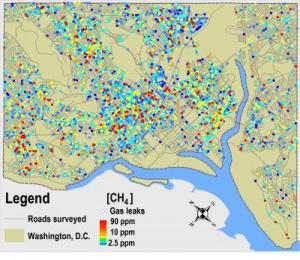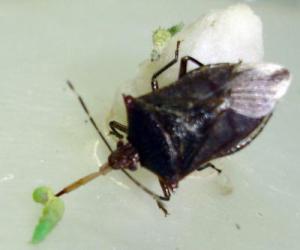Watch Where You’re Walking!
If you’re texting while walking, you’re not paying attention to everything going on around you. That’s obviously bad when it comes to crossing the street or avoiding collisions with innocent pedestrians. But did you know that messing with your mobile phone alters the way you walk too?
A new study compares how people walk normally with what happens while they’re texting or reading on their phones. In particular, test subjects who texted walked slower, moved their necks less, and had more trouble staying on a straight line. The research by Siobhan Schabrun and her colleagues at the University of Queensland appears in PLOS One.
In the press release announcing the study, Schabrun says, “Texting, and to a lesser extent reading, on your mobile phone affects your ability to walk and balance. This may impact the safety of people who text and walk at the same time.”
Duh! This conclusion that seems so obvious that you wonder why it was necessary to study it. Yet if it were so obvious, you’d think people wouldn’t be texting while walking in the first place.
Unfortunately, common sense isn’t so common. But, hey, spread the word about the study anyway.
Maybe one or two people will wait until they’re standing or sitting somewhere safe to text. Otherwise, feel free to shout out if someone tapping away at their phone is about to mow you over.
Best Title of 2014…So Far

Damage from the magnitude 6.7 Northridge earthquake on Jan. 17, 1994. Credit: U.S. Geological Survey
You have to love the title of this article from NASA. In my view, it’s the best science article title I’ve seen in 2014–at least so far.
It’s impressive how NASA imaging technology helps gauge earthquake risks. And while the earthquake was a disaster, I can’t help but be somewhat awed by the fact that Andrea Donnellan of NASA’s Jet Propulsion Laboratory published a paper on the potential severity of such an earthquake just a few months before it actually happened.
Science is spectacular!
Twenty years ago this week, in the predawn darkness of Jan. 17, 1994, at five seconds before 4:31 a.m. PST, the ground ruptured violently on a blind thrust fault. . . .
READ MORE____
http://www.jpl.nasa.gov/news/news.php?release=2014-014&1&utm_source=iContact&utm_medium=email&utm_campaign=NASAJPL&utm_content=releases20140116
An Explosive Situation
Our nation’s capital faces an explosive situation. You can’t see it, but danger lurks beneath the city’s streets.

This map shows where researchers found natural gas leaks under D.C. city streets. Credit: Duke University. http://www.eurekalert.org/multimedia/pub/67229.php?from=258055
Researchers from Duke University and Boston University report finding approximately 5,900 natural gas pipeline leaks under Washington, D.C. The report appears in the peer-reviewed journal, Environmental Science & Technology.
Methane concentrations at some manholes were as high as 500,000 parts per million, or ppm. That’s roughly 10 times more than the threshold for triggering an explosion. The number of explosion risks was small—about a dozen out of the 5,893 leaks mapped in the study. Nonetheless, any explosion of methane in a large city could cause substantial injury and property damage.
If the leaks were part of an action movie, they’d be the result of a rogue team of terrorists. In real life, aging infrastructure is the culprit.
Washington isn’t the only city with problems. Other cities with aging pipelines have problems too. Last year, the research team mapped more than 3,300 natural gas pipeline leaks beneath Boston.
The fact that natural gas is leaking should come as no surprise to either gas companies or those who regulate them. “Natural Gas Pipeline Leaks Cost Consumers Billions,” says the title of a report prepared for Senator Edward Markey (D-MA) last August.
Among other things, the Markey report found:
Gas distribution companies in 2011 reported releasing 69 billion cubic feet of natural gas to the atmosphere, almost enough to meet the state of Maine’s gas needs for a year and equal to the annual carbon dioxide emissions of about six million automobiles.
Despite knowing about the leaks, companies replaced just 3 percent of their cast iron or bare steel distribution mains in 2012. Those types of mains “leak 18 times more gas than plastic pipes and 57 times more gas than protected steel,” says the Markey report.
Companies have had little incentive to make upgrades as long as they can pass the costs of lost gas along to consumers. In money terms, consumers pay about a billion dollars more per year, reports Forbes. In human terms, the cost is higher. From 2000 to 2012, 116 people died in leak-related explosions.
In November, Senator Markey introduced proposed legislation to speed up the replacement of aging pipeline infrastructure. If enacted, the bills would supplement existing authority for fixing leaky pipes and improving regulation. That authority includes the Pipeline Safety, Regulatory Certainty, and Job Creation Act of 2011.
Natural gas isn’t just a source of energy. It’s also a greenhouse gas. Stopping the leaks is one instance where it would seem both political parties should come together to do something to reduce greenhouse gas emissions. After all, doing nothing is already costing billions of dollars and putting lives in danger.
The leaky pipeline problem also highlights an issue in ongoing energy debates. In Ohio, State Senator Bill Seitz sponsored a bill last year to substantially relax the state’s renewable energy and energy efficiency standards. The bill raised rousing criticisms from consumer groups and environmental groups.
Seitz and others have argued that the standards are not necessary any more because there’s plenty of cheap natural gas around. But here’s the thing: Natural gas wouldn’t be so cheap if the providers had to pay for all the infrastructure updates themselves.
This doesn’t mean the pipeline aid programs are a bad idea. To the contrary, they may be very necessary. Without help, companies might delay making repairs longer. They would also probably pass most of the costs along to consumers. That could cause substantial hardship to families who already struggle to pay their heat and other utility bills.
By the same token, politicians and utilities can’t credibly argue against renewable energy and energy efficiency standards on economic grounds. The true cost of fossil fuels is higher than the price that shows up on customers’ heat and electric bills. And the free market isn’t quite as free as many claim. Government programs have long subsidized fossil fuels, and they continue to do so.
To argue otherwise could blow up in politicians’ faces.
The Kick in Kickstarter
What’s the difference between Pebble and Ninja Baseball? One is an Internet-linked watch that’s more advanced than anything Dick Tracy ever had. The other is a video game. But if you look at the results of their Kickstarter campaigns, the difference is more than $10 million.
Now a new study from the Georgia Institute of Technology suggests the language used in Kickstarter campaigns has a lot to do with whether they succeed or fail. Yes, ideas count for a lot. But when researchers Tanushree Mitra and Eric Gilbert completed their detailed statistical analysis, they found that words win people over—or not. They wrote:
“We find that among 59 control variables and 20,391 phrases, the top 100 predictors of funded and not funded are solely comprised of phrases.”
Successful campaigns often used phrases that suggest some sort of reciprocity, social identity, or social reinforcement. The idea is that if you give, you will receive something—good karma, reinforcement, a reward, or whatever. Words suggesting authority, scarcity, and liking also tended to predict success.
On the other hand, phrases that seemed like groveling were likely to backfire. “Even a dollar” might help a project get closer to its goal, but the phrase was often associated with funding failures in the study. Other failing phrases suggested a lack of confidence, command, or clear planning. Examples were “hope to get,” “not been able,” or “later I.”
The researchers’ results will likely guide future fundraising campaigns. Meanwhile, the study underscores what we all know deep down: Words matter.
The words we use say something about us. And those same words trigger responses from other people.
Choose your words wisely—whether you’re on Kickstarter or not.
What Color Were Your Dinosaurs?
What child doesn’t like toy dinosaurs? In real life, they were the biggest creatures on Earth. Yet you can pick a toy one up in your hand and make it do whatever you want. Some fly. Others swim. Still others lumber across lush landscapes of the imagination.
Plus, the plastic comes in neat colors. Blue and green and purple dinosaurs roamed around my make-believe world of the Mesozoic Era.
It wasn’t until later that I learned that those vivid colors weren’t scientifically accurate. They were just the product of the toymakers’ imaginations—and their desire to sell more toys with eye-popping colors. All we had left of the real dinosaurs were their bones, so no one knew what color they really were. Chances were their colors weren’t too far from those of today’s reptiles.
Now new research reveals the first direct evidence about what colors prehistoric animals were. An international team of scientists from Denmark, Sweden, the United States, and Great Britain analyzed fossilized skin pigment. The material came from three multi-million-year old marine reptiles.
The research doesn’t reveal that the animals came in the bright plastic colors I remember from my toy box. But it does show evidence of at least some dark skin coloring.
“The pigment melanin is almost unbelievably stable,” noted Per Uvdal of Sweden’s Lund University in an announcement about the study. The study appears this week in the journal Nature.
Possible functions for the coloring include better heat regulation, camouflage, and protection from ultraviolet radiation. Skin coloring generally serves similar functions today.
I’m skeptical about whether toymakers will take the new study into account for future manufacturing. But I’d be willing to be most of the research team played with toy dinosaurs at one point or another when they were kids.
Cool Stink Bug Eggs
Hey, kids! Have you ever thought about raising bugs for money? Rearing the right bugs can help combat crop pests. And now new research offers guidance that can make it easier for companies and labs to raise one particularly helpful stink bug, Podisus nigrispinus (Dallas).

A Podisus nigrispinus stink bug preys on a caterpillar. Image courtesy of Alessandra Marieli Vacari.
Also known as the Brazilian spined soldier bug, Podisus nigrispinus (Dallas) preys on leaf-eating caterpillars. Yes, most of us remember Eric Carle’s The Very Hungry Caterpillar as a charming picture book. But the wrong kinds of caterpillars can destroy fields of corn, kale, cotton, soybeans, and other crops.
In the new study, Alessandra Vacari at São Paulo State University in Brazil and her colleagues incubated the helpful stink bug eggs at different temperatures. They found that the best temperature for storing the eggs is 15 degrees Celsius, which is 59 degrees Fahrenheit. That’s cool enough for most of us to want a sweater or light jacket, but significantly warmer than your refrigerator.
“Our results suggest that low temperatures can be used to store eggs for mass rearing of this potential biological control agent,” the authors conclude. Then farmers could coordinate the bugs’ release with pest outbreaks. The study appears in the January 2014 issue of the Annals of the Entomological Society of America.
This sounds like a great idea and is certainly worth further study. I can also see it as potential fodder for sci-fi writers’ imaginations. Watch for giant, mutant, out-of-control stink bugs coming soon to a movie screen near you!
If you’re on the road, stay off the phone!
Anyone who’s driven in a car with me has probably heard me rail against drivers on cell phones. Texting is even worse. And way too many drivers are dilly-dallying with their phones or other tasks instead of driving.
Drivers spend about 10 percent of their time using phones or doing tasks that take their eyes off the road, says a study in today’s New England Journal of Medicine. It’s not just that these folks are flaunting the law. They’re also endangering the lives of other people.
In the study, researchers from the National Institutes of Health and the Virginia Tech Transportation Institute used cameras and sensors to track test subjects’ behavior behind the wheel over a period of 12 to 18 months. Dialing a cell phone doubled the risk of a crash or near miss for experienced adult drivers. Reaching for the phone raised the odds about 37 percent.
For teen drivers, the risks of distracted driving were much higher. Texting raised the risk of a crash or near miss by a factor of about 4. Tasks like dialing and reaching for the phone increased the odds 7 or 8 times.
For your own good and for everyone else out there on the road, please make one more New Year’s resolution: If you’re on the road, stay off the phone!
Keeping this resolution is entirely doable. If the phone rings, let it ring. If you need to check something, pull over and stop. Keep your eyes and your attention on the road.
Happy New Year!


